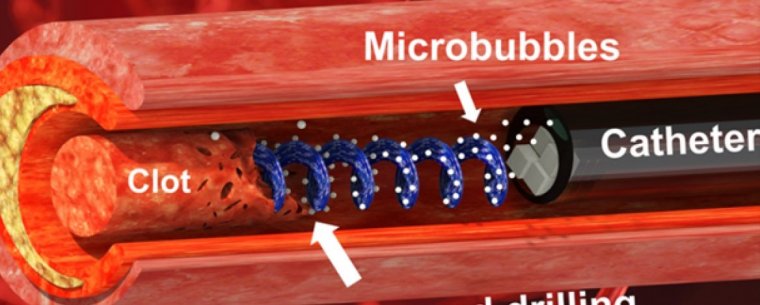| News / Science News |
New tool uses ultrasound 'tornado' to break down blood clots
Researchers have developed a new tool and technique that uses "vortex ultrasound" – a type of ultrasonic tornado – to break down blood clots in the brain. The new approach works faster than existing techniques to eliminate clots formed in an in vitro model of cerebral venous sinus thrombosis, or CVST.

Researchers have developed a new tool that uses "vortex ultrasound" to break down blood clots in the brain. Photo: Xiaoning Jiang and Chengzhi Shi
"Our previous work looked at techniques that use ultrasound to eliminate blood clots using what are essentially forward-facing waves, " says Xiaoning Jiang, co-corresponding author of a paper on the work.
"Our new work uses vortex ultrasound, where the ultrasound waves have a helical wavefront."
"In other words, the ultrasound is swirling as it moves forward," says Jiang, who is at North Carolina State University.
"Based on our in vitro testing, this approach eliminates blood clots more quickly than existing techniques, largely because of the shear stress induced by the vortex wave. A reason our work here is important is that current treatments for CVST fail in 20%-40% of cases."
CVST occurs when a blood clot forms in the veins responsible for draining blood from the brain. Incidence rates of CVST were between two and three per 100,000 in the United States in 2018 and 2019, and the incidence rate appears to be increasing.
"The fact that our new technique works quickly is important, because CVST clots increase pressure on blood vessels in the brain, " says Georgia Tech's Chengzhi Shi, co-corresponding author of the work.
"This increases the risk of a hemorrhage in the brain, which can be catastrophic for patients."
"Existing techniques rely in large part on interventions that dissolve the blood clot. But this is a time-consuming process. Our approach has the potential to address these clots more quickly, reducing risk for patients.”
The new tool consists of a single transducer that is specifically designed to produce the swirling, vortex effect, likened to a tornado. The transducer is small enough to be incorporated into a catheter, which is then fed through the circulatory system to the site of the blood clot.
"Based on available data, pharmaceutical interventions to dissolve CVST blood clots take at least 15 hours, and average around 29 hours, " Shi says.
"During in vitro testing, we were able to dissolve an acute blood clot in well under half an hour. " (U.S. National Science Foundation)
YOU MAY ALSO LIKE





